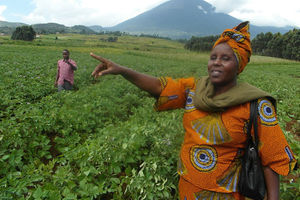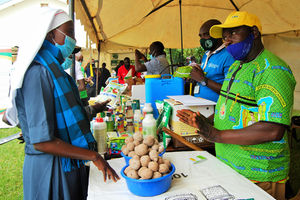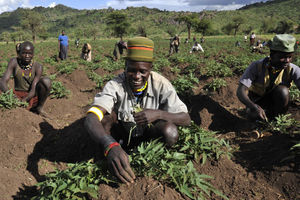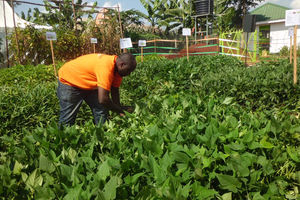
Farmers demonstrate how to plant Irish potatoes. Photo/ Lominda Afedraru
Irish potato is both a staple food and a source of income for the farmers in Uganda and 60 percent of the crop is produced in the highlands of southwestern Uganda and eastern Uganda on the slopes of Mt Elgon.
However due of the high demand of the tuber farmers in the entire country are adopting it as a commercial crop.
As such this requires farmers to have knowledge of best practices to be adopted to obtain high yields. Details of best practices are in a farmers guide prepared by experts from Bern University of Applied Sciences, School of Agricultural, Forest and Food Sciences in Switzerland with a consortium of NGO’s with funding from the European Union for Irish potato growers in northern Uganda.
The ideal site for Irish potato farming should have well-drained, sandy loam soil with a pH of 5.5 to 6.5. The soil should be fertile and rich in organic matter. The site should also receive full sun for at least 6-8 hours per day.
Heavy clay soils are only suitable if well-drained and ploughed. Sandy, light soils tend to dry out quickly.
The soil should be deep, well-drained, and loose for proper tuber development. Slightly sloping fields dry and drain quicker but the fields should not be too steep to avoid soil erosion.
Land preparation
The land should be ploughed or tilled to a depth of 8 to 12 inches. This will help to loosen the soil and improve drainage.
Organic matter such as compost or manure should be added to the soil to improve its fertility. The soil should then be levelled and raked smooth. When ploughing using animal traction, hand hoe or tractor the ploughing should be done across the slope to control soil erosion.
Burning of vegetation should be avoided as this leaves the soil bare and exposes the garden to soil erosion.
Seed selection
The quality of seed is highly relevant for successful potato production. The planting material should be free of seed-borne diseases.
Whenever possible, farmers should buy certified seed potatoes but such material may not be available or may be too expensive. One alternative is to produce seed potato at farmer level with the seed plot technique.
Potato is normally propagated vegetatively by small tubers, called seed tubers. It can also be propagated by pieces of tuber or by true seed.
Planting
Irish potatoes are typically planted at the onset of the rainy season. The seed potatoes should be cut into pieces with two or three eyes each.
The pieces should be planted 4 to 6 inches deep and 12 to 18 inches apart. The rows should be 2 to 3 feet apart. The tubers can be planted on ridges or on flat land.
The ridges should be 15 to 30 cm high, 60 to100 cm apart and the tubers are then planted each 30 to 40cm in rows. On top of the ridges, a planting depth of 5 to10 cm depth is optimal, the potato should be covered properly with soil after planting.
Nutrient application
Potatoes like any other crop require adequate soil nutrients for growth and development and for better yield.
The following three nutrients are important for potato growth, high nitrogen demand from the emergence stage until the tuber initiation.
Appropriate nitrogen supply within the first 35 days after emergence is optimal for leaf growth resulting in good tuber development. If the nitrogen supply is too high, new leaves and stems will develop constantly which results in large, dense foliage. This can delay tuber formation.
Potassium demand is generally high for potatoes and important for the development of starch. It also improves shelf life and reduces the number of damaged tubers.
Care
Irish potato plants should be watered regularly, especially during dry periods. The soil should be kept moist but not soggy. The plants should also be fertilised every few weeks with a balanced fertiliser.
Weeding should be done early to avoid competition for light, nutrients and to prevent weeds from acting as alternative host for pests and diseases.
The first weeding is normally done two to three weeks after planting or the first weeding can be done when the plants are 10cm high and the second one when the plants are 25cm high.
Crop rotation
Proper crop rotation enhances soil fertility, increases soil organic matter, conserves soil moisture and helps maintain soil structure.
In addition, it avoids the build-up of soil-borne pathogens and reduces the level of soil infestation once the soil has been contaminated.
Potatoes should not be grown more often than one season in three years in the same garden.
Planting brassicas such as broccoli, cabbage, and mustard plants before the potato crop helps reduce incidence of bacterial wilt and nematodes.
Pest and disease control
Irish potato plants are susceptible to a number of pests and diseases. Common pests include potato beetles, aphids, and leafhoppers. Common diseases include late blight, early blight, and scab.
Farmers can manage it using crop rotation, removing affected plants, storing and transporting tubers in dry containers, and using healthy clean seeds.
Harvesting Irish potatoes
Irish potato plants are typically harvested 75 to 140 days after planting. The potatoes are mature when the vines start to die back. The potatoes are dug up with a potato fork or spade. Harvesting should be done in dry weather and under slight moist soil conditions. Harvest is done using hoes which are forked to reduce the rate of tubers damaged by an ordinary hoe. It is important to be careful not to cut tubers during harvest.




